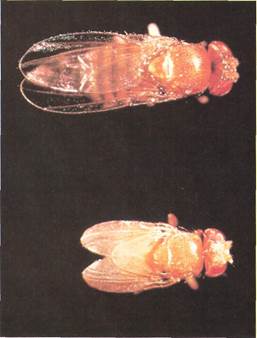
CATEGORIES:
BiologyChemistryConstructionCultureEcologyEconomyElectronicsFinanceGeographyHistoryInformaticsLawMathematicsMechanicsMedicineOtherPedagogyPhilosophyPhysicsPolicyPsychologySociologySportTourism
The tips of plant shoots
respond to light by growing toward it. This principle is demonstrated by these barley shoots. The middle shoot is bent toward the right (the direction of the light source). The other two are not because their tips are covered by foil caps. This response to light occurs as a result of hormones (called auxins) secreted by the tips of the shoots.
 |

|
Breadmaking,like brewing, is an ancient biotechni-cal process. Both use yeast fermentation, resulting in the production of carbon dioxide. In the case of bread-making, the carbon dioxide makes the bread dough
Genetic engineeringinvolves modifying an organism's chromosomes and thus the genes they carry. The fruit fly above IDro-sophila sp.l is normal, whereas the lower one is a dwarf mutant whose genes were altered by irradiation.
Biotechnology
For thousands of years, people have exploited the biochemical activities of living cells. Bread-and beermaking, for example, depend upon the ability of microscopic yeast cells to convert sugars to carbon dioxide and ethanol (ordinary alcohol). Cheese- and yogurtmaking also depend on the activities of single-celled life forms—the microorganisms.
Every microorganism is a tiny factory. Each one is capable of carrying out the basic biochemical functions described earlier in this section. Human understanding of biochemistry has grown dramatically in the past few decades. This explosion of science is now providing the basis for a new industry—biotechnology.
Industrial enzymes
An enzyme is an organic catalyst, a protein substance that influences a chemical reaction,

normally within plants and animals. Throughout the reaction, the enzyme itself remains unchanged. Simple examples of the use of enzymes outside of their natural environment include fermentation, the gradual chemical change of a substance, such as yeast. Yeast fermentation (as in making beer) occurs because of a series of enzymes present in the yeast cells. This catalytic activity of an enzyme does not depend on its being inside a cell. Many enzymes produced naturally by microorganisms exist outside cells. For example, they may be released from the cell into the surrounding medium. There, the enzymes break down some of the substances in the medium into molecules. The cell can then absorb these molecules as food.
Many different enzymes have now been isolated as pure chemicals. Some are produced on a very large scale, usually in a relatively crude form. They are used as industrial materials. Washing powders today often contain "biologically active" ingredients. These are enzymes intended to improve the efficiency of washing by biodegrading insoluble (not dissolvable) materials, such as protein. Such materials make up part of the dirt on clothes.
Enzymes are also used in various ways in food manufacture. For example, one method of making a chocolate with a liquid center is to start with a solid center. Then, an enzyme is added, which breaks down part of the solid content of a liquid after the chocolate surrounding it has hardened.
Date: 2015-12-11; view: 1803
| <== previous page | | | next page ==> |
| The metamorphic stages | | | Large-scale biotechnology |